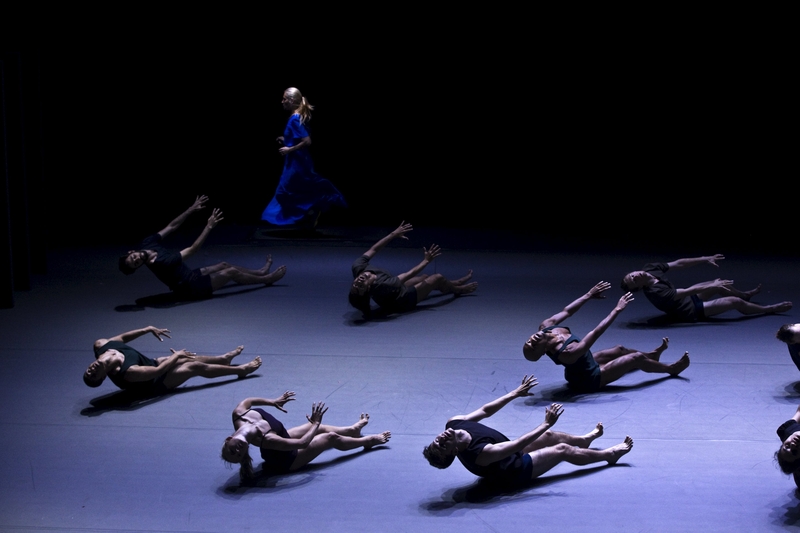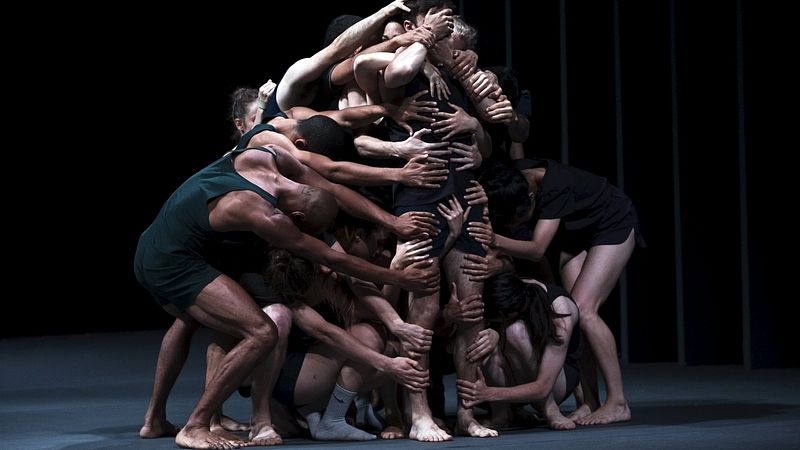 This year‘s edition of the international festival Dance Prague culminated in two evenings with the famous Israeli ensemble Batsheva Dance Company. The new piece by Ohad Naharin, artistic director of the company, is called Last Work – we have already reviewed its premiere in Hellerau, Dresden. But it is necessary to mention how the choreography was accepted by the Czech audience and also to add some interesting details we learned during the meeting with Batsheva dancers after their performance in Prague.
The Karlín Musical Theatre was packed to see the performance on Wednesday 24, 2015. The professional dance community as well as Dance Prague‘s faithful audience gathered in a large number to be present at the dance event of the season. The Czech capital resonates with the name of the Israeli company, and especially its choreographer who was among the first world-famous artists whose work was imported during the first years of the Dance Prague festival and has been brought repeatedly into our country since then (for the first time his choreography was performed by NDT II in 1989). Moreover, the National Theatre balletcompany has recently premiered a new piece Decadance, consisting of Ohad Naharin’s works, which was praised by both the audiences and the critics. Yet this year, Naharin’s main company visited Prague for the very first time.
During the after-performance discussion with Batsheva artists we were assured that Last Work is not Naharin’s final piece and that in Hebrew the title means ‘latest’ rather that ‘last’. It should definitely not sound pathetic or fatalistic. Though, the choreography seems very much a fatal one. Its structure is different from other Naharin works, kaleidoscopes of older pieces which can be seen performed by dance companies world-wide and which are tailored by Naharin to fit the individual ensembles - he creates new works only for his own company. Last Work is a homogenous piece, and although there is much happening on stage – from slow solo improvisations to large group sequences, the dancers even have time to change their costumes (right on stage) – but it has a unifying mood and line running from the beginning to the end. The strongest element is probably a woman in a blue dress - she is placed upstage, running on one spot (on a treadmill) throughout the whole performance. Is it a metaphor of the time passing? The movement vocabulary clearly stemmed from Naharin’s gaga style and despite the ever-changing dynamics and situations, the dancers’ movement was always fascinating. Each performer was unique not only in terms of technique but also in terms of the personal energy radiating from the stage.
Besides, it is the awakening of hidden human energy that Naharin sets as a goal of his technique. At the same time, the piece was exhausting for some reason, for both the dancers and the audience. The constant tension was accentuated by slow, booming electronic music. Its monotonous pace contrasted with the action on stage where eighteen dancers were moving in solos and group compositions. The slow tempo of the music was interrupted towards the end of the performance when it was replaced by fast beats that made the dancers flounce in frantic creations. No hint of lightness or humour appeared in the choreography. On the contrary, the tension was growing until the final scene which, besides ecstatic dance, was filled with symbols like white flag, giant clapper (serving to expelling the devil during the Jewish holiday of Purim), machine gun and microphone tied up by duct tape. These objects were the only specific links to the possible pacifistic message of the piece, though we cannot take them too seriously – the symbols were so obvious that they seemed more like a parody. Did the author mean these elements seriously or not, the omnipresent feeling of the unavoidable and of depression was getting under your skin throughout the whole piece. It was strong enough even without any clear allusions.
This year‘s edition of the international festival Dance Prague culminated in two evenings with the famous Israeli ensemble Batsheva Dance Company. The new piece by Ohad Naharin, artistic director of the company, is called Last Work – we have already reviewed its premiere in Hellerau, Dresden. But it is necessary to mention how the choreography was accepted by the Czech audience and also to add some interesting details we learned during the meeting with Batsheva dancers after their performance in Prague.
The Karlín Musical Theatre was packed to see the performance on Wednesday 24, 2015. The professional dance community as well as Dance Prague‘s faithful audience gathered in a large number to be present at the dance event of the season. The Czech capital resonates with the name of the Israeli company, and especially its choreographer who was among the first world-famous artists whose work was imported during the first years of the Dance Prague festival and has been brought repeatedly into our country since then (for the first time his choreography was performed by NDT II in 1989). Moreover, the National Theatre balletcompany has recently premiered a new piece Decadance, consisting of Ohad Naharin’s works, which was praised by both the audiences and the critics. Yet this year, Naharin’s main company visited Prague for the very first time.
During the after-performance discussion with Batsheva artists we were assured that Last Work is not Naharin’s final piece and that in Hebrew the title means ‘latest’ rather that ‘last’. It should definitely not sound pathetic or fatalistic. Though, the choreography seems very much a fatal one. Its structure is different from other Naharin works, kaleidoscopes of older pieces which can be seen performed by dance companies world-wide and which are tailored by Naharin to fit the individual ensembles - he creates new works only for his own company. Last Work is a homogenous piece, and although there is much happening on stage – from slow solo improvisations to large group sequences, the dancers even have time to change their costumes (right on stage) – but it has a unifying mood and line running from the beginning to the end. The strongest element is probably a woman in a blue dress - she is placed upstage, running on one spot (on a treadmill) throughout the whole performance. Is it a metaphor of the time passing? The movement vocabulary clearly stemmed from Naharin’s gaga style and despite the ever-changing dynamics and situations, the dancers’ movement was always fascinating. Each performer was unique not only in terms of technique but also in terms of the personal energy radiating from the stage.
Besides, it is the awakening of hidden human energy that Naharin sets as a goal of his technique. At the same time, the piece was exhausting for some reason, for both the dancers and the audience. The constant tension was accentuated by slow, booming electronic music. Its monotonous pace contrasted with the action on stage where eighteen dancers were moving in solos and group compositions. The slow tempo of the music was interrupted towards the end of the performance when it was replaced by fast beats that made the dancers flounce in frantic creations. No hint of lightness or humour appeared in the choreography. On the contrary, the tension was growing until the final scene which, besides ecstatic dance, was filled with symbols like white flag, giant clapper (serving to expelling the devil during the Jewish holiday of Purim), machine gun and microphone tied up by duct tape. These objects were the only specific links to the possible pacifistic message of the piece, though we cannot take them too seriously – the symbols were so obvious that they seemed more like a parody. Did the author mean these elements seriously or not, the omnipresent feeling of the unavoidable and of depression was getting under your skin throughout the whole piece. It was strong enough even without any clear allusions.
 Politics is not that important
The performance was followed by a discussion that was attended by one of the dancers – Omri Drumlevich – and rehearsal director Luc Jacobs. It appears that Ohad Naharin trusts his dancers so much that he lets them interpret his work, which is very valuable. On the other hand, we have to regret that we could not ask the Master himself as he did not show up at all. Besides the frequently asked questions about the gaga technique, working with music and the degree of improvisation, many people were concerned about the importance of political message of Naharin’s choreography. Rather surprisingly, for many of them, Omri Drumlevich said that the political allusion is actually not important for them. The essential part is movement and how it affects the audience and the political agitation is rather irrelevant – the artistic element still dominates over all the other layers of the piece. He is convinced that even if they danced in front of someone from the occupied zone, the work would still be appreciated for its artistic values and not for the political message. It is interesting to hear how the Israeli people themselves understand their art and how it is perceived in Europe. Each allusion to war, each motif of violence or fear are sensed so strongly here, especially when it comes to the company from the Middle East. But for them these things make of part of everyday reality, that is why they use such topics as something perfectly normal and they do not lay any particular stress on them… I am not sure what is more depressing: the situation in which they live or the detachment from reality in which we live here.
Written from the performance held on 24 June 2015, Karlín Musical Theatre.
Last Work
Choreography: Ohad Naharin
Light design: Avi Yona Bueno (Bambi)
Politics is not that important
The performance was followed by a discussion that was attended by one of the dancers – Omri Drumlevich – and rehearsal director Luc Jacobs. It appears that Ohad Naharin trusts his dancers so much that he lets them interpret his work, which is very valuable. On the other hand, we have to regret that we could not ask the Master himself as he did not show up at all. Besides the frequently asked questions about the gaga technique, working with music and the degree of improvisation, many people were concerned about the importance of political message of Naharin’s choreography. Rather surprisingly, for many of them, Omri Drumlevich said that the political allusion is actually not important for them. The essential part is movement and how it affects the audience and the political agitation is rather irrelevant – the artistic element still dominates over all the other layers of the piece. He is convinced that even if they danced in front of someone from the occupied zone, the work would still be appreciated for its artistic values and not for the political message. It is interesting to hear how the Israeli people themselves understand their art and how it is perceived in Europe. Each allusion to war, each motif of violence or fear are sensed so strongly here, especially when it comes to the company from the Middle East. But for them these things make of part of everyday reality, that is why they use such topics as something perfectly normal and they do not lay any particular stress on them… I am not sure what is more depressing: the situation in which they live or the detachment from reality in which we live here.
Written from the performance held on 24 June 2015, Karlín Musical Theatre.
Last Work
Choreography: Ohad Naharin
Light design: Avi Yona Bueno (Bambi) Soundtrack Design and Editing: Maxim Warratt
Original music: Grischa Lichtenberger
Sets: Zohar Shoef
Costumes: Eri Nakamura
Assistents of Ohad Naharin a Maxim Warratt: Ariel Cohen a Guy Shomroni
Music accompaniment: Few Mysteries Solved in a Year of Contact – Sagat, Club Life – Hysterics, Crusty Juice – MPIA3,Volume VIP – Monkey, Tantrum – Luminox
Production: Hila Razon
Running trainer: Mark Or Translation: Tereza Cigánková




Josef Bartos
Thank you for your thoughts. One got stuck in my mind – that passion makes us different from AI. Just yesterday I read…I am a dance critic. I am a member of an endangered species